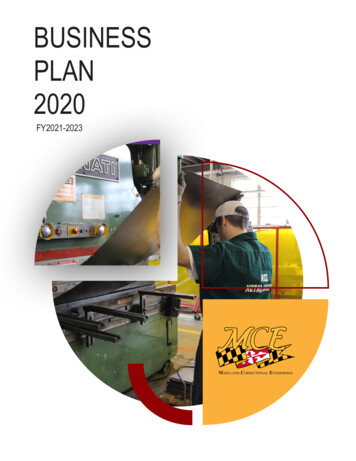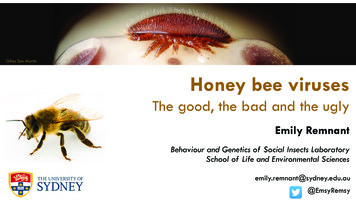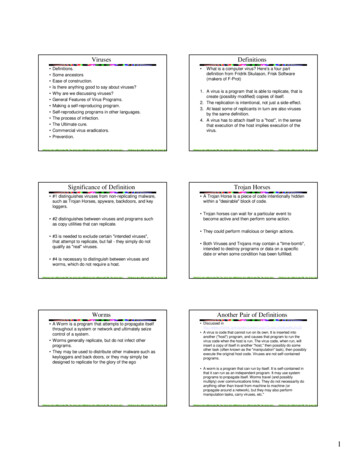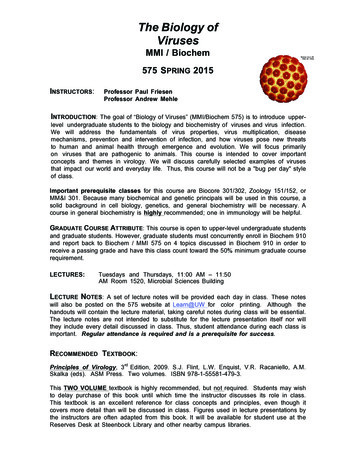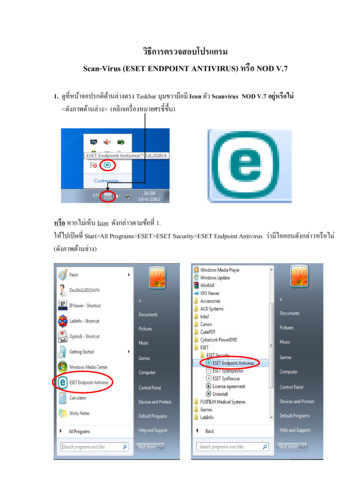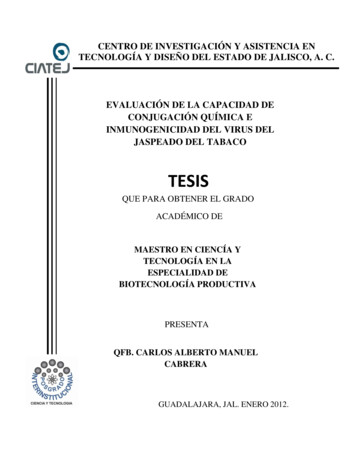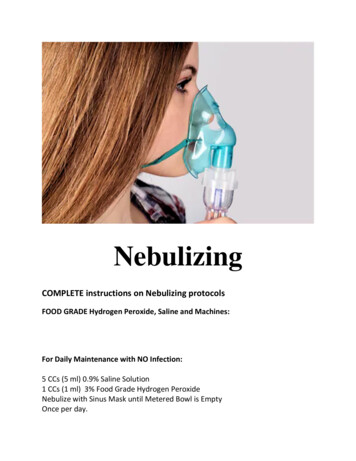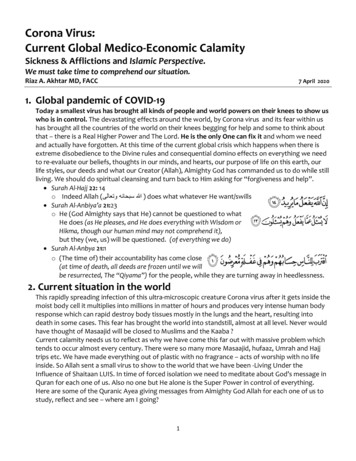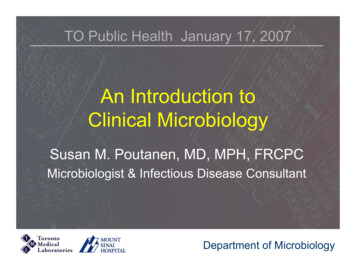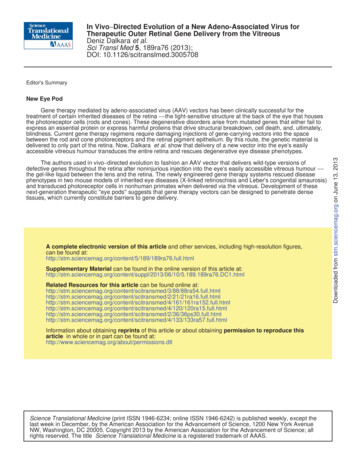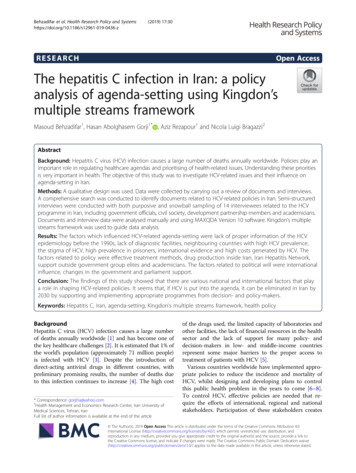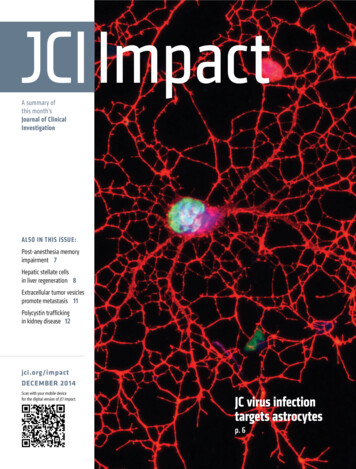
Transcription
A summary ofthis month’sJournal of ClinicalInvestigationAlso in this issue:Post-anesthesia memoryimpairment 7Hepatic stellate cellsin liver regeneration 8Extracellular tumor vesiclespromote metastasis 11Polycystin traffickingin kidney disease 12jci.org/impactDecember 2014Scan with your mobile devicefor the digital version of JCI Impact.JC virus infectiontargets astrocytesp. 6
Journal of Clinical InvestigationConsulting EditorsAlejandro AballayAbul K. AbbasDomenico AcciliRexford S. AhimaQais Al-AwqatiKari AlitaloJames AllisonDario C. AltieriMasayuki AmagaiMark E. AndersonBrian H. AnnexAlan AttieJane E. AubinSteven P. BalkMichael F. BeersJohn A. BelperioNina BhardwajMorris J. BirnbaumJoyce BischoffMina J. BissellCraig BlackstoneBruce R. BlazarNancy BoniniBrendan BoyceJonathan BrombergFrank C. BrosiusHal E. BroxmeyerAndrew ButlerMichael J. CaplanRuben D. CarrascoDiego H. CastrillonHarold ChapmanAjay ChawlaBenjamin K. ChenBenny J. ChenJu ChenMarie-Françoise ChesseletVivian G. CheungYongwon ChoiThomas ClemensRonald G. CollmanMarco ColonnaGeorge CotsarelisShaun R. CoughlinChristopher M. CounterPeter D. CromptonTyler J. CurielDavid D’alessioRichard T. D’AquilaRiccardo Dalla-FaveraTheresa A. GuiseDavid HaflerJonathan J. HansenRaymond C. HarrisStanley L. HazenPeter HeeringaBrian A. HemmingsMeenhard HerlynCalvin KuoAntonio La CavaFadi G. LakkisTerri LauferMitchell A. LazarBrendan LeeWilliam M.F. LeeRudolph L. LeibelEdward PlowJeffrey PollardKornelia PolyakCatherine PosticJosef PrchalAlice S. PrinceLouis J. PtáčekLuigi PuglielliAlan DaughertyTed DawsonSudhansu DeyHarry C. Dietz IIIMichael DustinConnie J. EavesDominique EladariJack A. EliasJoel K. ElmquistStephen G. EmersonJeffrey A. EngelmanJonathan A. EpsteinAdrian ErlebacherJoel D. ErnstJames M. ErvastiRobert V. Farese Jr.Eric R. FearonEdward A. FisherSusan FisherRichard A. FlavellTatiana ForoudVelia M. FowlerMartin FriedlanderStephen J. GalliJ. Victor Garcia-MartinezAlfred L. George Jr.Stanton L. GersonRobert E. GersztenTodd GoldeStanley GoldfarbLarry B. GoldsteinFred Sanford GorelickKathleen J. GreenJ. Timothy GreenamyreJoachim HerzKatherine A. HighHelen H. HobbsRonald HoffmanV. Michael HolersSteven M. HollandMichael J. HoltzmanLawrence B. HolzmanTamas L. HorvathGokhan S. HotamisligilSteven R. HouserScott J. HultgrenChristopher A. HunterCiro IndolfiDavid E. JamesWilliam G. Kaelin Jr.Klaus KaestnerMark L. KahnRaghu KalluriS. Ananth KarumanchiRobert S. KassMasato KasugaDontscho KerjaschkiSundeep KhoslaRichard N. KitsisPeter S. KleinSteven KliewerBjörn C. KnollmannWalter J. KochJay K. KollsIssei KomuroChristopher D. KontosMurray KorcGary KoretzkyStanley M. LemonJon D. LevineRoss L. LevineKlaus LeyRichard M. LocksleyGary LopaschukRichard B. MailmanAndrew R. MarksJack MartinSteven O. MarxRodger P. McEverElizabeth McNallyCornelius J. MeliefShlomo MelmedGeorge MichalopoulosJeffrey H. MinerBeverly MitchellPeter J. MohlerKelle Harbert MoleyJeffrey MolkentinDavid D. MooreEdward E. MorriseyJames H. MorrisseyDeborah M. MuoioAnthony J. MuslinMartin G. Myers Jr.Benjamin G. NeelEric N. OlsonHarry T. OrrWilliam C. ParksWarren S. PearRichard M. Peek Jr.Sallie R. PermarDavid J. PinskyPere PuigserverBali PulendranEllen PuréSusan E. QuagginMarlene RabinovitchDaniel J. RaderShahin RafiiGwendalyn J. RandolphBarbara RehermannSteven L. ReinerSarah A. RobertsonPaul B. RosenbergTheodora S. RossMarc E. RothenbergAnil RustgiJ. Evan SadlerJunichi SadoshimaJose-Alain SahelJean E. SchafferPhilipp E. SchererMichael D. SchneiderDetlef SchuppanMichael W. SchwartzWilliam K. ScottRandy SeeleyAmita SehgalClay SemenkovichGregg L. SemenzaJohn SeykoraSteven D. ShapiroMari ShinoharaSteven E. ShoelsonGerald I. ShulmanRoy L. SilversteinM. Celeste SimonMihaela SkobeLois SmithSteven R. SmithSusan S. SmythWeihong SongAshley L. St. JohnHerman F. StaatsJonathan S. StamlerJohn R. StanleyColin L. StewartDoris StoffersWarren StroberMaureen A. SuKatalin SusztakCatharina SvanborgIra TabasAlan R. TallSakae TanakaVictor J. ThannickalAndrei Thomas-TikhonenkoGeorgia D. TomarasPeter TontonozLaurence A. TurkaRaphael H. ValdiviaMarcel R.M. van den BrinkLuc Van KaerMatthias von HerrathYisong Y. WanHong WangDavid WeinstockJeffrey WeiserStephen J. WeissBart O. WilliamsJoseph C. WuThomas A. WynnRudolf ZechnerKang ZhangLen ZonMing-Hui ZouWeiping Zou
ImpactDecember 2014EditorHoward A. RockmanDeputy EditorsGarnett Kelsoe, Bryan L. RothAssociate EditorsSoman N. Abraham, Vann Bennett,Gerard C. Blobe, Kathleen M. Caron,Marc G. Caron, John P. Chute,Thomas M. Coffman, Anna Mae Diehl,Ronald J. Falk, Michael B. Kastan,Daniel P. Kelly, Mary E. Klotman,Rodger A. Liddle, Nigel Mackman,Larry G. Moss, Deborah M. Muoio,Christopher B. Newgard, Paul W. Noble,Cam Patterson, Geoffrey S. Pitt,Jeffrey C. Rathmell, W. Kimryn Rathmell,Jonathan S. Serody, Norman Sharpless,Yiping YangClinical Medicine Associate EditorsMichael A. Morse, Andrew J. Muir,Scott M. Palmer, Mark A. StacyAsia EditorDavid M. VirshupChair, Executive CouncilRobert J. LefkowitzBiostatisticiansCynthia Coffman, Barry Moser,Maren OlsenBioethicistArthur L. CaplanSenior Science EditorSarah C. JacksonScience EditorJillian HurstAssistant Science EditorCorinne WilliamsEditor at LargeUshma S. NeillFeatured EditorThe JCI’s Editorial Board is composed of peer scientists at Duke University Medical Center, the University ofNorth Carolina, Duke-NUS, and the Sanford-Burnham Medical Research Institute. Editorial Board membersreview and oversee peer review of each manuscript that is submitted to the JCI, and the board meets weeklyto discuss the manuscripts undergoing review.Cam Patterson, M.D., M.B.A., Associate Editor, isthe senior Vice President and Chief OperatingOfficer of New York-Presbyterian Hospital/WeillCornell Medical Center in New York. He was previously Physician-in-Chief of the UNC Center forHeart and Vascular Care, the Chief of the Divisionof Cardiology, and the Director of the McAllisterHeart Institute at the University of North Carolinaat Chapel Hill. Dr. Patterson’s research interestsare in the areas of angiogenesis and vasculardevelopment, cardiac hypertrophy, protein qualitycontrol, and translational genomics and metabolomics. His major research accomplishments include the characterization of therole of ubiquitin ligases and protein quality control mechanisms in cardiac structure and function; the discovery of transcriptional mechanisms that determineendothelial cell specification; and discovery and biochemical characterizationof stress-dependent ubiquitin ligases such as CHIP. Dr. Patterson is the founderof two biotechnology companies, Dyzen Inc. and Enci Therapeutics. He is anEstablished Investigator of the American Heart Association, a recipient of theJudah Folkman Award in Vascular Biology, a Burroughs Wellcome Fund ClinicalScientist in Translational Research, a member of the American Society for Clinical Investigation, and President of the Association of Professors of Cardiology.Publication highlightsWillis MS, Patterson C. Proteotoxicity and cardiac dysfunction — Alzheimer’sdisease of the heart? N Engl J Med. 2013;368(5):455–464.Xie L, Pi X, Mishra A, Fong G, Peng J, Patterson C. PHD3-dependenthydroxylation of HCLK2 promotes the DNA damage response. J Clin Invest.2012;122(8):2827–2836.Pi X, Schmitt CE, Xie L, Portbury AL, Wu Y, Lockyer P, Dyer LA, Moser M,Bu G, Flynn EJ 3rd, Jin SW, Patterson C. LRP1-dependent endocytic mechanismgoverns the signaling output of the bmp system in endothelial cells and inangiogenesis. Circ Res. 2012;111(5): 564–574.ISSN 2324-7703 (print)ISSN 2325-4556 (online)The American Society for Clinical Investigation holdsthe rights to and publishes the Journal of ClinicalInvestigation. The opinions expressed herein aresolely those of the authors and are not necessarilyendorsed by the ASCI.the journal of clinical investigationFor the full JCIonline, go tojci.me/124/12or scan the codeat left with yourmobile device.jci.org/impactContact the JCIThe Journal of Clinical Investigation2015 Manchester RoadAnn Arbor, Michigan 48104, USAPhone: 734.222.6050E-mail: staff@the-jci.orgdecember 20141
Research articles in thecurrent issue of the JCICardiologyCardiac myocyte–secreted cAMP exerts paracrine action via adenosinereceptor activationExtracellular cAMPYassine Sassi, Andrea Ahles, Dong-Jiunn Jeffery Truong, Younis Baqi, Sang-Yong Lee, Britta Husse, Jean-Sébastien Hulot,Ariana Foinquinos, Thomas Thum, Christa E. Müller, Andreas Dendorfer, Bernhard Laggerbauer,and Stefan Engelhardt http://jci.me/74349DermatologyA GRHL3-regulated repair pathway suppresses immune-mediated epidermal hyperplasiaWilliam M. Gordon, Michael D. Zeller, Rachel H. Klein, William R. Swindell, Hsiang Ho, Francisco Espetia, Johann E. Gudjonsson, Pierre F. Baldi,and Bogi Andersen http://jci.me/77138More, p. 9GeneticsHair keratin mutations in tooth enamel increase dental decay riskOlivier Duverger, Takahiro Ohara, John R. Shaffer, Danielle Donahue, Patricia Zerfas, Andrew Dullnig, Christopher Crecelius,Elia Beniash, Mary L. Marazita, and Maria I. Morasso http://jci.me/78272Molar fissuresHepatologyKetogenesis prevents diet-induced fatty liver injury and hyperglycemiaDavid G. Cotter, Baris Ercal, Xiaojing Huang, Jamison M. Leid, D. André d’Avignon, Mark J. Graham, Dennis J. Dietzen, Elizabeth M. Brunt, Gary J. Patti,and Peter A. Crawford http://jci.me/76388More, p. 8Hepatic stellate cells contribute to progenitor cells and liver regenerationClaus Kordes, Iris Sawitza, Silke Götze, Diran Herebian, and Dieter Häussinger http://jci.me/74119With related Commentary by Christopher J. Hindley, Gianmarco Mastrogiovanni,and Meritxell HuchHepatic stellate cellsMore, p. 8ImmunologyTGR5 reduces macrophage migration through mTOR-induced C/EBPβ differential translationAlessia Perino, Thijs Willem Hendrik Pols, Mitsunori Nomura, Sokrates Stein, Roberto Pellicciari, and Kristina Schoonjans http://jci.me/762892the journal of clinical investigationjci.org/impactdecember 2014
Research articles in the current issue of the JCIInherited BCL10 deficiency impairs hematopoietic and nonhematopoietic immunityJuan Manuel Torres, Rubén Martinez-Barricarte, Sonia García-Gómez, Marina S. Mazariegos, Yuval Itan, Bertrand Boisson, Rita Álvarez, Anaïs Jiménez-Reinoso,Lucia del Pino, Rebecca Rodríguez-Pena, Antonio Ferreira, Enrique Hernández-Jiménez, Victor Toledano, Carolina Cubillos-Zapata, Mariana Díaz-Almirón,Eduardo López-Collazo, José L. Unzueta-Roch, Silvia Sánchez-Ramón, Jose R. Regueiro, Eduardo López-Granados, Jean-Laurent Casanova,and Rebecca Pérez de Diego http://jci.me/77493Thymic stromal lymphopoietin–mediated epicutaneous inflammation promotes acute diarrheaand anaphylaxisHongwei Han, Tennille D. Thelen, Michael R. Comeau, and Steven F. Ziegler http://jci.me/77798More, p. 9Circulating T follicular regulatory and helper cells havememory-like propertiesPeter T. Sage, David Alvarez, Jernej Godec, Ulrich H. von Andrian, and Arlene H. Sharpe http://jci.me/76861T follicular cells in lymph nodeInherited STING-activating mutation underlies a familial inflammatorysyndrome with lupus-like manifestationsNadia Jeremiah, Bénédicte Neven, Matteo Gentili, Isabelle Callebaut, Sophia Maschalidi, Marie-Claude Stolzenberg,Nicolas Goudin, Marie-Louis Frémond, Patrick Nitschke, Thierry J. Molina, Stéphane Blanche, Capucine Picard, Gillian I. Rice, Yanick J. Crow, Nicolas Manel,Alain Fischer, Brigitte Bader-Meunier, and Frédéric Rieux-Laucat http://jci.me/79100IL-12–producing monocytes and HLA-E control HCMV-driven NKG2C NK cell expansionAlexander Rölle, Julia Pollmann, Eva-Maria Ewen, Vu Thuy Khanh Le, Anne Halenius, Hartmut Hengel, and Adelheid Cerwenka http://jci.me/77440NephrologyAltered trafficking and stability of polycystins underlie polycystic kidney diseaseYiqiang Cai, Sorin V. Fedeles, Ke Dong, Georgia Anyatonwu, Tamehito Onoe, Michihiro Mitobe, Jian-Dong Gao, Dayne Okuhara, Xin Tian, Anna-Rachel Gallagher,Zhangui Tang, Xiaoli Xie, Maria D. Lalioti, Ann-Hwee Lee, Barbara E. Ehrlich, and Stefan Somlo http://jci.me/67273More, p. 12NeuroscienceSustained increase in α5GABAA receptor function impairs memory after anesthesiaAgnieszka A. Zurek, Jieying Yu, Dian-Shi Wang, Sean C. Haffey, Erica M. Bridgwater, Antonello Penna, Irene Lecker, Gang Lei, Tom Chang, Eric W.R. Salter,and Beverley A. Orser http://jci.me/76669More, p. 7Human glial chimeric mice reveal astrocytic dependence of JC virus infectionYoichi Kondo, Martha S. Windrem, Lisa Zou, Devin Chandler-Militello, Steven J. Schanz, Romane M. Auvergne,Sarah J. Betstadt, Amy R. Harrington, Mahlon Johnson, Alexander Kazarov, Leonid Gorelik,and Steven A. Goldman http://jci.me/76629JC virus–infected astrogliaWith related Commentary by Sheila A. Haley and Walter J. AtwoodMore, p. 6Spastic paraplegia proteins spastizin and spatacsin mediate autophagic lysosome reformationJaerak Chang, Seongju Lee, and Craig Blackstone http://jci.me/77598More, p. 7the journal of clinical investigationjci.org/impactdecember 20143
Research articles in the current issue of the JCIOncologySphingosine-1-phosphate lyase downregulation promotes coloncarcinogenesis through STAT3-activated microRNAsActive STAT3 in colonEmilie Degagné, Ashok Pandurangan, Padmavathi Bandhuvula, Ashok Kumar, Abeer Eltanawy, Meng Zhang,Yuko Yoshinaga, Mikhail Nefedov, Pieter J. de Jong, Loren G. Fong, Stephen G. Young, Robert Brittman,Yasmin Ahmedi, and Julie D. Saba http://jci.me/74188Targeting miR-23a in CD8 cytotoxic T lymphocytes prevents tumor-dependent immunosuppressionRegina Lin, Ling Chen, Gang Chen, Chunyan Hu, Shan Jiang, Jose Sevilla, Ying Wan, John H. Sampson, Bo Zhu, and Qi-Jing Li http://jci.me/76561Membrane protein CNNM4–dependent Mg2 efflux suppresses tumor growthYosuke Funato, Daisuke Yamazaki, Shin Mizukami, Lisa Du, Kazuya Kikuchi, and Hiroaki Miki http://jci.me/76614Targeting an IKBKE cytokine network impairs triple-negative breastcancer proliferationIKBKE in breast cancerThanh U. Barbie, Gabriela Alexe, Amir R. Aref, Shunqiang Li, Zehua Zhu, Xiuli Zhang, Yu Imamura, Tran C. Thai,Ying Huang, Michaela Bowden, John Herndon, Travis J. Cohoon, Timothy Fleming, Pablo Tamayo, Jill P. Mesirov,Shuji Ogino, Kwok-Kin Wong, Matthew J. Ellis, William C. Hahn, David A. Barbie,and William E. Gillanders http://jci.me/75661More, p. 11NOTCH-induced aldehyde dehydrogenase 1A1 deacetylation promotes breast cancer stem cellsDi Zhao, Yan Mo, Meng-Tian Li, Shao-Wu Zou, Zhou-Li Cheng, Yi-Ping Sun, Yue Xiong, Kun-Liang Guan, and Qun-Ying Lei http://jci.me/76611More, p. 10Tumor-associated neutrophils stimulate T cell responses in early-stage human lung cancerEvgeniy B. Eruslanov, Pratik S. Bhojnagarwala, Jon G. Quatromoni, Tom Li Stephen, Anjana Ranganathan, Charuhas Deshpande, Tatiana Akimova, Anil Vachani,Leslie Litzky, Wayne W. Hancock, José R. Conejo-Garcia, Michael Feldman, Steven M. Albelda, and Sunil Singhal http://jci.me/77053More, p. 10Germinal center reentries of BCL2-overexpressing B cells drive follicularlymphoma progressionB cells in germinal centerStéphanie Sungalee, Emilie Mamessier, Ester Morgado, Emilie Grégoire, Philip Z. Brohawn, Christopher A. Morehouse,Nathalie Jouve, Céline Monvoisin, Cédric Menard, Guilhaume Debroas, Mustapha Faroudi, Violaine Mechin,Jean-Marc Navarro, Charlotte Drevet, Franziska C. Eberle, Lionel Chasson, Fannie Baudimont, Stéphane J. Mancini,Julie Tellier, Jean-Michel Picquenot, Rachel Kelly, Paolo Vineis, Philippe Ruminy, Bruno Chetaille, Elaine S. Jaffe,Claudine Schiff, Jean Hardwigsen, David A. Tice, Brandon W. Higgs, Karin Tarte, Bertrand Nadel,and Sandrine Roulland http://jci.me/72415With related Commentary by Srividya Swaminathan and Markus MüschenMore, p. 10miR-200–containing extracellular vesicles promote breast cancer cell metastasisMinh T.N. Le, Peter Hamar, Changying Guo, Emre Basar, Ricardo Perdigão-Henriques, Leonora Balaj, and Judy Lieberman http://jci.me/75695With related Commentary by David M. EpsteinMore, p. 11Long noncoding RNA EWSAT1-mediated gene repression facilitates Ewing sarcoma oncogenesisMichelle Marques Howarth, David Simpson, Siu P. Ngok, Bethsaida Nieves, Ron Chen, Zurab Siprashvili, Dedeepya Vaka, Marcus R. Breese, Brian D. Crompton,Gabriela Alexe, Doug S. Hawkins, Damon Jacobson, Alayne L. Brunner, Robert West, Jaume Mora, Kimberly Stegmaier, Paul Khavari,and E. Alejandro Sweet-Cordero http://jci.me/721244the journal of clinical investigationjci.org/impactdecember 2014
Research articles in the current issue of the JCIGP130 activation induces myeloma and collaborates with MYCSTAT3 in multiple myelomaTobias Dechow, Sabine Steidle, Katharina S. Götze, Martina Rudelius, Kerstin Behnke, Konstanze Pechloff,Susanne Kratzat, Lars Bullinger, Falko Fend, Valeria Soberon, Nadya Mitova, Zhoulei Li, Markus Thaler, Jan Bauer,Elke Pietschmann, Corinna Albers, Rebekka Grundler, Marc Schmidt-Supprian, Jürgen Ruland, Christian Peschel,Justus Duyster, Stefan Rose-John, Florian Bassermann, and Ulrich Keller http://jci.me/69094Preexisting oncogenic events impact trastuzumab sensitivity in ERBB2-amplifiedgastroesophageal adenocarcinomaJihun Kim, Cameron Fox, Shouyong Peng, Mark Pusung, Eirini Pectasides, Eric Matthee, Yong Sang Hong, In-Gu Do, Jiryeon Jang, Aaron R. Thorner,Paul Van Hummelen, Anil K. Rustgi, Kwok-Kin Wong, Zhongren Zhou, Ping Tang, Kyoung-Mee Kim, Jeeyun Lee, and Adam J. Bass http://jci.me/75200LYN-activating mutations mediate antiestrogen resistance in estrogenreceptor–positive breast cancerLYN in breast cancerLuis J. Schwarz, Emily M. Fox, Justin M. Balko, Joan T. Garrett, María Gabriela Kuba, Mónica Valeria Estrada,Ana María González-Angulo, Gordon B. Mills, Monica Red-Brewer, Ingrid A. Mayer, Vandana Abramson,Monica Rizzo, Mark C. Kelley, Ingrid M. Meszoely, and Carlos L. Arteaga http://jci.me/72573RASAL2 activates RAC1 to promote triple-negative breast cancer progressionMin Feng, Yi Bao, Zhimei Li, Juntao Li, Min Gong, Stella Lam, Jinhua Wang, Diego M. Marzese, Nicholas Donovan, Ern Yu Tan, Dave S.B. Hoon,and Qiang Yu http://jci.me/76711PulmonologyTRPV4 mediates myofibroblast differentiation and pulmonary fibrosisin miceMurine myofibroblastsShaik O. Rahaman, Lisa M. Grove, Sailaja Paruchuri, Brian D. Southern, Susamma Abraham, Kathryn A. Niese,Rachel G. Scheraga, Sudakshina Ghosh, Charles K. Thodeti, David X. Zhang, Magdalene M. Moran,William P. Schilling, Daniel J. Tschumperlin, and Mitchell A. Olman http://jci.me/75331More, p. 9Reproductive biologyHyaluronan in cervical epithelia protects against infection-mediatedpreterm birthCervical epitheliaYucel Akgul, R. Ann Word, Laura M. Ensign, Yu Yamaguchi, John Lydon, Justin Hanes,and Mala Mahendroo http://jci.me/78765Vascular biologyOxido-reductive regulation of vascular remodeling by receptor tyrosine kinase ROS1Ziad A. Ali, Vinicio de Jesus Perez, Ke Yuan, Mark Orcholski, Stephen Pan, Wei Qi, Gaurav Chopra, Christopher Adams, Yoko Kojima, Nicholas J. Leeper, Xiumei Qu,Kathia Zaleta-Rivera, Kimihiko Kato, Yoshiji Yamada, Mitsutoshi Oguri, Allan Kuchinsky, Stanley L. Hazen, J. Wouter Jukema, Santhi K. Ganesh, Elizabeth G. Nabel,Keith Channon, Martin B. Leon, Alain Charest, Thomas Quertermous, and Euan A. Ashley http://jci.me/77484With related Commentary by Judy B. de HaanMore, p. 12Targeting sortilin in immune cells reduces proinflammatory cytokines and atherosclerosisMartin B. Mortensen, Mads Kjolby, Stine Gunnersen, Jakob V. Larsen, Johan Palmfeldt, Erling Falk, Anders Nykjaer,and Jacob F. Bentzon http://jci.me/76002the journal of clinical investigationjci.org/impactdecember 20145
ResearchEditor’s picksA human glial chimeric model for JC virus infectionProgressive multifocal leukoencephalopathy is arare demyelinating disorder that is caused by JCvirus (JCV) infection of glial cells. JCV is commonly found in the general population, but onlytriggers disease in people with a compromisedimmune system, such as HIV-positive individuals or those on immunosuppressive regimens.JCV is specific to human glial cells, and thelack of an appropriate animal model has hampered studies of the in vivo phenotypes of viralinfection. In a study in this month’s JCI, StevenGoldman and colleagues showed that humanized glial chimeric mice can be infected withJCV, and they took advantage of this system toexplore the targets for JCV in the brain. Althoughthe demyelination observed in patients had longsuggested that oligodendrocytes might be theprimary target of JCV, the research team surprisingly found that astrocytes were the preferentialtarget of viral infection in cultured cells. Furthermore, they demonstrated in vivo that astrocytespromoted viral replication much more efficientlythan oligodendrocytes. Using mice chimeric forhuman astrocytes and glial progenitor cells butnot oligodendrocytes, the researchers subsequently showed that astroglia are sufficient tosupport infection and viral spread in vivo. Theirstudies support a model in which astrocytesserve as the primary reservoir for infection, witholigodendrocyte cell death and demyelinationoccurring as secondary effects. In an accompanying commentary, Haley and Atwood discusshow the development of an animal model provides an important tool for studying JC viruspathogenesis and treatment. The image hereshows a JCV-infected oligodendrocyte stainedfor oligodendrocyte marker O4 (red), phosphop53(Ser15) (green), and viral T antigen (blue).6Human glial chimeric mice reveal astrocytic dependenceof JC virus infectionYoichi Kondo, Martha S. Windrem, Lisa Zou, Devin Chandler-Militello, Steven J. Schanz,Romane M. Auvergne, Sarah J. Betstadt, Amy R. Harrington, Mahlon Johnson, Alexander Kazarov,Leonid Gorelik, and Steven A. Goldman http://jci.me/76629Related CommentaryAn animal model for progressive multifocal leukoencephalopathySheila A. Haley and Walter J. Atwood http://jci.me/79186the journal of clinical investigationjci.org/impactdecember 2014
Research Editor’s picksneuroscienceHereditary spastic paraplegia genes maintain lysosomal biogenesisHereditary spastic paraplegias (HSPs) are a group of disorders characterized by distal axondegeneration of long corticospinal neurons. The two most common autosomal recessive HSPsare caused by loss-of-function mutations in spatacsin (SPG11) and spastizin (SPG15). In thisissue, Craig Blackstone and colleagues demonstrated that spatacsin and spastizin play acritical role in maintaining a sufficient supply of lysosomes during autophagic clearance ofintracellular components. During autophagy, intracellular components are enclosed in adouble-membrane vesicle known as an autophagosome. The autophagosome then fuses witha lysosome to form an autolysosome, and the contents are degraded by lysosomal proteases.New lysosomes can be generated by autophagic lysosome reformation (ALR). Using cell linesand patient fibroblasts, Blackstone and colleagues found that loss of spastizin or spatacsinresulted in the accumulation of autolysosomes. Mechanistically, spastizin and spatacsin form acomplex on autolysosomes that is required for lysosome tubulation, the first step of ALR. Lossof ALR results in accumulation of autophagic materials, thereby contributing to neurodegeneration (see the accompanying image).Spastic paraplegia proteins spastizin and spatacsin mediateautophagic lysosome reformationJaerak Chang, Seongju Lee, and Craig Blackstone http://jci.me/77598Postanesthesia memoryimpairment is caused byincreased GABAA receptor activityGeneral anesthesia is frequently associated with cognitive dysfunction andmemory deficits that can last for many days after an operation. Moreover, theduration of anesthesia is positively correlated with the incidence of such deficits.In this issue, Agnieszka Zurek and colleagues identify mechanisms underlyingpostoperative cognitive dysfunction. They found that mice treated with a single,sedative dose of the common GABAergic anesthetic etomidate experiencedmemory impairment for up to 72 hours after exposure. Experiments usinghippocampal slices from mice treated with a single dose of etomidate revealed areduction in synaptic plasticity and a sustained increase in tonic current andcell-surface expression of α5GABAA receptors (α5GABAARs). Changes inα5GABAAR expression persisted for up to one week after anesthesia, indicatingthat changes in receptor expression may underlie persistent memory deficitsafter anesthesia. Furthermore, the memory-impairing effects of etomidate werereversed by α5GABAAR inhibition.Sustained increase in α5GABAA receptor function impairsmemory after anesthesiaAgnieszka A. Zurek, Jieying Yu, Dian-Shi Wang, Sean C. Haffey,Erica M. Bridgwater, Antonello Penna, Irene Lecker, Gang Lei, Tom Chang,Eric W.R. Salter, and Beverley A. Orser http://jci.me/76669the journal of clinical investigationjci.org/impactdecember 20147
Research Editor’s pickshepatologyHepatic stellate cells participatein liver regenerationThe liver is distinguished from otherorgans by its ability to regenerate; however,it is not entirely clear which cells contributeto this process. Hepatic stellate cells(HSCs), which reside in the space of Dissewithin the liver, contain high levels ofretinoids and show characteristics ofmesenchymal stem cells (MSCs) from theBM, suggesting that they serve as a form ofliver-resident MSC. Claus Kordes andcolleagues investigated the contribution ofHSCs to liver regeneration by isolating HSCs from GFP-expressing rats and transplanting them into WTrats that underwent partial hepatectomy in the presence of toxic substances, which suppresshepatocyte proliferation. The transplanted HSCs engrafted in the BM and homed to the injured liver.Additionally, they differentiated into mesenchymal and epithelial cells such as cholangiocytes andhepatocytes (see the accompanying image) by transient formation of hepatic progenitor cells. In therelated Commentary, Meritxell Huch and colleagues discuss how these findings alter the currentunderstanding of HSCs.Hepatic stellate cells contribute to progenitor cells and liver regenerationClaus Kordes, Iris Sawitza, Silke Götze, Diran Herebian, and Dieter Häussingerhttp://jci.me/74119Related CommentaryThe plastic liver: differentiated cells, stem cells, every cell?Christopher J. Hindley, Gianmarco Mastrogiovanni, and Meritxell Huchhttp://jci.me/78372Burning fat in nonalcoholic fatty liver diseaseNonalcoholic fatty liver disease (NAFLD) is themost common liver disease in Western countriesand is associated with insulin resistance, metabolicsyndrome, and obesity. Because much of the liver’sfat can be disposed of through ketogenesis,researchers hypothesized that defects inketogenesis drive NAFLD spectrum disorders. DavidCotter, Baris Ercal, Xiaojing Huang, and colleaguesdemonstrate that ketogenesis prevents dietinduced steatohepatitis in mice. Geneticallyinduced ketogenic insufficiency in adult micestimulated excess glucose and lipid production bythe liver. High fat/high carbohydrate feeding ofketogenesis-insufficient mice caused a cascade of8metabolic abnormalities in the liver, widespreadhepatocyte injury, and hepatic inflammation. Theseresults demonstrate that hepatic ketogenesispreserves metabolic dynamics in the setting ofovernutrition and suggest that therapeuticstrategies targeting ketogenesis could potentiallybe used to treat NAFLD.Ketogenesis prevents diet-inducedfatty liver injury and hyperglycemiaDavid G. Cotter, Baris Ercal, Xiaojing Huang,Jamison M. Leid, D. André d’Avignon,Mark J. Graham, Dennis J. Dietzen,Elizabeth M. Brunt, Gary J. Patti, andPeter A. Crawford http://jci.me/76388the journal of clinical investigationjci.org/impactdecember 2014
Research Editor’s picksdermatologyThe transcription factor GRHL3 attenuatesimmune-mediated skin damageImmune-mediated skin diseases such as psoriasis are characterized bythe infiltration of T cells into the epidermis. While T cells secrete cytokinesthat contribute to disease, the epidermis also produces an array ofmolecules, but it is unclear how they affect pathogenesis. In this issue,William Gordon and colleagues demonstrate that the transcription factorgrainyhead-like 3 (GRHL3) is required for the repair of barrier-disruptingepidermal lesions in adult skin. In a murine model of immune-mediatedskin damage, loss of GRHL3 resulted in increased skin damage comparedwith WT animals. Grhl3-deficient animals exhibited impaired epidermalbarrier repair, increased immune cell infiltration (see the accompanyingimage), and delayed lesion healing. Chromatin immunoprecipitationstudies and gene expression profiling indicated that GRHL3 suppresses theexpression of inflammatory genes after immune injury.A GRHL3-regulated repair pathway suppressesimmune-mediated epidermal hyperplasiaWilliam M. Gordon, Michael D. Zeller, Rachel H. Klein, William R. Swindell,Hsiang Ho, Francisco Espetia, Johann E. Gudjonsson, Pierre F. Baldi,and Bogi Andersen http://jci.me/77138pulmonologyimmunologyLung fibrogenesis is regulatedby cation channel TRPV4Linking atopic dermatitisand gastrointestinal allergyIdiopathic pulmonary fibrosis (IPF) is a fatal lung disorder inwhich the tissue becomes scarred and fibrotic, impeding lungfunction. Myofibroblasts, which mediate fibrosis, are generatedby both TGF-β signaling and mechanical signals such as matrixstiffness; however, the mechanisms whereby myofibroblastssense and transmit mechanical signals are unclear. In this issue,Shaik Rahaman and colleagues demonstrated that the transientreceptor potential vanilloid 4 (TRPV4) channel mediatesmechanical signals that trigger myofibroblast differentiation.They showed that IPF lung fibroblasts have enhanced TRPV4activity. Moreover, genetic ablation or pharmacological inhibitionof TRPV4 blocks myofibroblast differentiation and fibrosis in amurine IPF model (see the accompanying image). These dataidentify a TRPV4 as a critical mediator of myofibroblastdifferentiation and suggest that TRPV4 modulation is a potentialtherapeutic strategy in IPF.TRPV4 mediates myofibroblast differ
Michael A. Morse, Andrew J. Muir, Scott M. Palmer, Mark A. Stacy Asia editor David M. Virshup Chair, executive Council Robert J. Lefkowitz Biostatisticians Cynthia Coffman, Barry Moser, Maren Olsen Bioethicist Arthur L. Caplan senior science editor Sarah C. Jackson science editor Jillian Hurst Assistant science editor Corinne Williams editor at .
